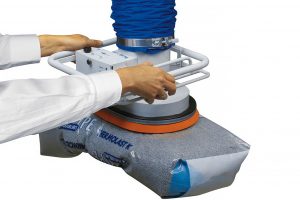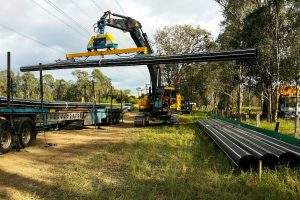In various industries, the use of vacuum lifters has revolutionised the way heavy objects are handled and transported. These versatile machines provide a reliable and efficient solution for lifting a wide range of products, from wooden boards to conveyor rollers and even large bearings. With their ability to securely grip objects without the need for manual effort, vacuum lifters have become indispensable in industries such as woodworking, airports, warehouses, steel factories, and glass manufacturing plants.
Vacuum Lifter Types:
 There are three primary types of vacuum lifters that cater to different industrial needs. The first type is the vacuum tube lifter, which employs a high-volume vacuum pump to secure the gripper head onto the product being lifted. By increasing the vacuum pressure, the lift tube compresses, generating the lifting force. Originally developed for the woodworking industry, these vacuum tube lifters have found widespread applications in diverse industry sectors. They are commonly utilised in airports to handle luggage, in warehouses for efficient carton movement and in manufacturing where all types of paper, plastic & poly-woven sacks are being lifted. Furthermore, these versatile machines are ideal for lifting unconventional products, such as conveyor rollers and large bearings, more & more we find that developing a special gripper head to handle customers’ products is what we’re doing to help resolve situations where people were the only option to do the lifting previously.
There are three primary types of vacuum lifters that cater to different industrial needs. The first type is the vacuum tube lifter, which employs a high-volume vacuum pump to secure the gripper head onto the product being lifted. By increasing the vacuum pressure, the lift tube compresses, generating the lifting force. Originally developed for the woodworking industry, these vacuum tube lifters have found widespread applications in diverse industry sectors. They are commonly utilised in airports to handle luggage, in warehouses for efficient carton movement and in manufacturing where all types of paper, plastic & poly-woven sacks are being lifted. Furthermore, these versatile machines are ideal for lifting unconventional products, such as conveyor rollers and large bearings, more & more we find that developing a special gripper head to handle customers’ products is what we’re doing to help resolve situations where people were the only option to do the lifting previously.
Depending on the model, vacuum tube lifters can perform horizontal, vertical, or even rotational lifts, making them adaptable to a wide range of tasks. With impressive speed and precision, they move almost as swiftly as the human hand. The operator’s role is limited to controlling the lift speed and accurately placing the item, significantly reducing physical strain and effort.
The second type of vacuum lifter is commonly employed in steel or glass factories. These lifters create a complete seal between the product and the gripper head, allowing for a smaller vacuum pump. Once the vacuum seal is established, the pump can often switch itself off, thanks to the airtight grip. In cases of minor vacuum leaks, the pump automatically activates to maintain a secure hold on the object. Unlike vacuum tube lifters, this type relies on a separate hoist, usually an electric chain hoist, to perform the actual lifting. However, various types of hoists can be utilised depending on the specific requirements. These vacuum lifters are often integrated into forklifts, excavators, skid steer machines, and other industrial equipment.
Custom and Specialised Grippers for Irregular Shape Items:
There are even  specialised lifters designed for outdoor applications, such as demolition and construction sites. These robust machines can handle the laying of large drainage pipes, weighing up to a staggering 20 tonnes each. The versatility and adaptability of these vacuum lifters make them essential tools in demanding and challenging work environments. They also significantly reduce the risk of injury to staff as more often than not these units are operated from within the machine cab, with no need for a dogman to be at the point of lift to secure slings etc. The third type of vacuum lifter shares similarities with the second but relies on an external air source to create the vacuum using a venturi system. This pneumatic vacuum lifter utilises compressed air to generate a low-pressure zone, resulting in a powerful vacuum. While it requires an additional air source, this type of lifter offers simplicity and reliability. Compressed air availability is a prerequisite for their usage, typically found in manufacturing plants.
specialised lifters designed for outdoor applications, such as demolition and construction sites. These robust machines can handle the laying of large drainage pipes, weighing up to a staggering 20 tonnes each. The versatility and adaptability of these vacuum lifters make them essential tools in demanding and challenging work environments. They also significantly reduce the risk of injury to staff as more often than not these units are operated from within the machine cab, with no need for a dogman to be at the point of lift to secure slings etc. The third type of vacuum lifter shares similarities with the second but relies on an external air source to create the vacuum using a venturi system. This pneumatic vacuum lifter utilises compressed air to generate a low-pressure zone, resulting in a powerful vacuum. While it requires an additional air source, this type of lifter offers simplicity and reliability. Compressed air availability is a prerequisite for their usage, typically found in manufacturing plants.
The advantages of using vacuum lifters in the workplace are manifold. Firstly, these machines significantly enhance efficiency by streamlining lifting processes. With the ability to handle heavy objects quickly and accurately, vacuum lifters reduce labour time and increase productivity. The ease of operation further contributes to enhanced efficiency. Operators only need to control the lift speed and position the item, minimising physical strain and eliminating the need for excessive manual effort. Additionally, vacuum lifters improve workplace safety by reducing the risk of injuries associated with manual lifting. With the elimination of heavy lifting and awkward postures, the potential for back strains, musculoskeletal disorders, and other work-related injuries is significantly diminished. Furthermore, vacuum lifters provide a secure grip on objects, preventing accidental drops and costly damage. This feature is especially crucial when dealing with fragile materials, such as glass, where the risk of breakage is high. By minimising product damage, vacuum lifters contribute to cost savings and maintain product quality.
 There are three primary types of vacuum lifters that cater to different industrial needs. The first type is the vacuum tube lifter, which employs a high-volume vacuum pump to secure the gripper head onto the product being lifted. By increasing the vacuum pressure, the lift tube compresses, generating the lifting force. Originally developed for the woodworking industry, these vacuum tube lifters have found widespread applications in diverse industry sectors. They are commonly utilised in airports to handle luggage, in warehouses for efficient carton movement and in manufacturing where all types of paper, plastic & poly-woven sacks are being lifted. Furthermore, these versatile machines are ideal for lifting unconventional products, such as conveyor rollers and large bearings, more & more we find that developing a special gripper head to handle customers’ products is what we’re doing to help resolve situations where people were the only option to do the lifting previously.
There are three primary types of vacuum lifters that cater to different industrial needs. The first type is the vacuum tube lifter, which employs a high-volume vacuum pump to secure the gripper head onto the product being lifted. By increasing the vacuum pressure, the lift tube compresses, generating the lifting force. Originally developed for the woodworking industry, these vacuum tube lifters have found widespread applications in diverse industry sectors. They are commonly utilised in airports to handle luggage, in warehouses for efficient carton movement and in manufacturing where all types of paper, plastic & poly-woven sacks are being lifted. Furthermore, these versatile machines are ideal for lifting unconventional products, such as conveyor rollers and large bearings, more & more we find that developing a special gripper head to handle customers’ products is what we’re doing to help resolve situations where people were the only option to do the lifting previously.
 specialised lifters designed for outdoor applications, such as demolition and construction sites. These robust machines can handle the laying of large drainage pipes, weighing up to a staggering 20 tonnes each. The versatility and adaptability of these vacuum lifters make them essential tools in demanding and challenging work environments. They also significantly reduce the risk of injury to staff as more often than not these units are operated from within the machine cab, with no need for a dogman to be at the point of lift to secure slings etc. The third type of vacuum lifter shares similarities with the second but relies on an external air source to create the vacuum using a venturi system. This pneumatic vacuum lifter utilises compressed air to generate a low-pressure zone, resulting in a powerful vacuum. While it requires an additional air source, this type of lifter offers simplicity and reliability. Compressed air availability is a prerequisite for their usage, typically found in manufacturing plants.
specialised lifters designed for outdoor applications, such as demolition and construction sites. These robust machines can handle the laying of large drainage pipes, weighing up to a staggering 20 tonnes each. The versatility and adaptability of these vacuum lifters make them essential tools in demanding and challenging work environments. They also significantly reduce the risk of injury to staff as more often than not these units are operated from within the machine cab, with no need for a dogman to be at the point of lift to secure slings etc. The third type of vacuum lifter shares similarities with the second but relies on an external air source to create the vacuum using a venturi system. This pneumatic vacuum lifter utilises compressed air to generate a low-pressure zone, resulting in a powerful vacuum. While it requires an additional air source, this type of lifter offers simplicity and reliability. Compressed air availability is a prerequisite for their usage, typically found in manufacturing plants.